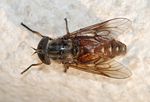Tabanidae
Also known as: Horse flies — Deerflies — Clegs
| Culicidae | |
|---|---|
| Kingdom | Animalia |
| Phylum | Arthropoda |
| Class | Insecta |
| Order | Diptera |
| Sub-order | Brachycera |
| Family | Tabanidae |
Introduction
Tabanidae flies are found throughout the world and although commonly being known as the horse fly they attack a wide variety of animals including humans. There are several genus of veterinary importance;
- Tabanus
- Chrysops - also known as deerflies
- Haematopota - also known as clegs
Recognition
- Adults
Tabanidae flies are large flies, up to 2.5cm long with bodies that are usually dark in colour. The dark bodies may have stripes or patches of colour down them or be entirely coloured in some cases. They have broad heads with biting mouth parts and bulging eyes that are often brightly coloured. The mouthparts are adapted to biting a sucking blood, and always point downwards. They consist of paired mandibles and maxillae which are used for cutting and rasping to create a feeding hole. Blood is then sucked using a protruding hypopharynx. The mouthparts are short and deal roughly with the host, this is often the cause of pain for the host. Only females take a blood meal, males lack mandibles and may only feed on honeydew and nectar. The wings of Tabanidae flies have a distinctive venation. The antennae are all in three segments but differ between the 3 important veterinary genus.
- Larvae
Tabanidae larvae are large, 1.5 - 3cm in length with large biting mandibles. They are off white in colour with longitudinal striations on the cuticle. There are paired unsegmented appendages, psuedopods, along the body to assist in movement. The posterior of the larvae usually has a respiratory siphon present.
- Eggs
Eggs are an off white colour and cigar shaped. They can be between 1 - 3 mm long.
Life Cycle
Tabanidae flies lay their eggs on the underside of leaves overhanging areas of water. When the eggs hatch the larvae fall from the leaves into the water where they remain for anywhere between 3 months and 3 years if overwintering occurs. Once the larvae have developed they move onto dry land to pupate. The pupa hatches after about 3 weeks and live flies emerge. In total this life cycle takes over one year to complete.
Pathogenesis
The Tabanidae flies in themselves are responsible for painful, irritating bites which can cause distress to the animal in question. They are most active on hot, sunny days and locate their prey by sight using their large bulbous eyes. As well as causing irritation when biting the flies act as mechanical vectors for a number of other pathogens;
- Bacteria such as anthrax and pasteurellosis
- Viruses such as Equine infectious anaemia and African horse sickness
- Rickettsiales, such as anaplasmosis
The Tabanidae flies may also act as intermediate host for some trypanosome species.
| Tabanidae Learning Resources | |
|---|---|
 Search for recent publications via CAB Abstract (CABI log in required) |
Tabanidae publications |
| This article has been peer reviewed but is awaiting expert review. If you would like to help with this, please see more information about expert reviewing. |
Error in widget FBRecommend: unable to write file /var/www/wikivet.net/extensions/Widgets/compiled_templates/wrt6939a56548f874_69029198 Error in widget google+: unable to write file /var/www/wikivet.net/extensions/Widgets/compiled_templates/wrt6939a565548832_86255148 Error in widget TwitterTweet: unable to write file /var/www/wikivet.net/extensions/Widgets/compiled_templates/wrt6939a5655b2409_40073143
|
| WikiVet® Introduction - Help WikiVet - Report a Problem |
